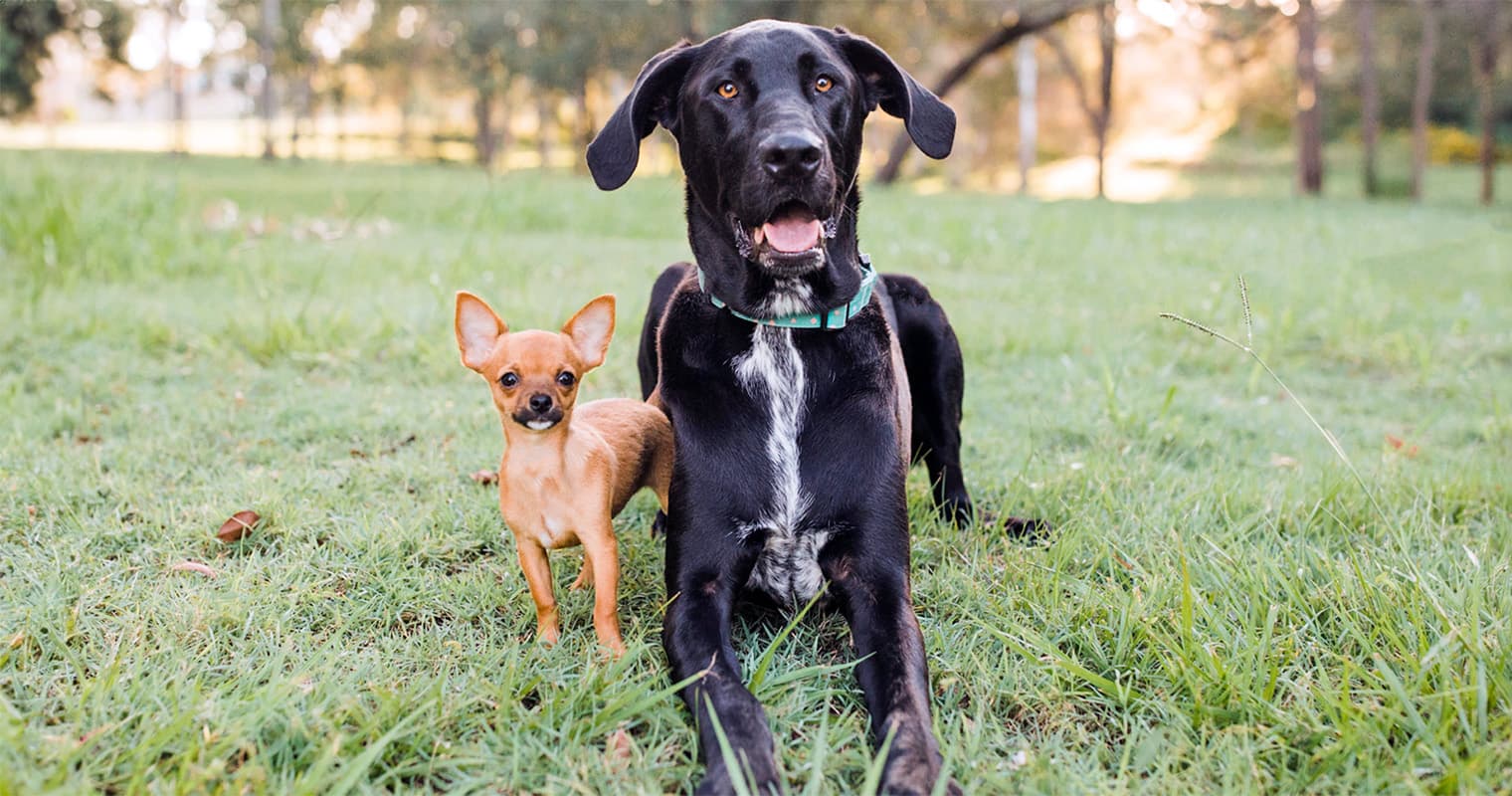Do Small Dogs Live Longer Than Large Dogs?
Discover the factors affecting a dog’s lifespan, and learn why size matters for your pet’s longevity.
Discover the factors affecting a dog’s lifespan, and learn why size matters for your pet’s longevity.
by Adrienne A. Kruzer, BBA, RVT, LVT, | March 5, 2025

Samantha Gehrmann / Stocksy
Dog parents often wonder if it’s true that smaller breeds, such as Chihuahuas, outlive their larger counterparts like Great Pyrenees — and if so, why? While it is true that on average, smaller dogs outlive larger dogs, there are a variety of factors that contribute to your dog’s lifespan.
This guide explores the science behind canine lifespan, key factors that influence longevity, and how you can help your dog have the best chance of living a long, healthy life. Dog breed size can matter when it comes to lifespan. Although you may have no control over how big your dog will get, you do have some control over other potential longevity altering factors.
TL;DR: Small dogs generally live longer than large dogs due to slower aging, fewer growth-related health issues, and genetic factors. Proper care, diet, and exercise also play a crucial role in a dog’s lifespan.
Yes, small dogs often live longer than large dogs. But this is not guaranteed, nor does it mean small breeds are always healthier than large breeds. A dog’s lifespan is determined by genetics and breed predisposition to specific diseases, lifestyle and environmental factors, and how quickly a dog grows.
How does size affect a dog’s lifespan? In the animal world, larger species don’t typically live as long as smaller species, and research has discovered why this may be true for dogs. One of the things that negatively affects a large dog’s lifespan is how quickly they age. Large breed dogs actually grow and age more quickly than small breed dogs.
This rapid growth and aging is thought to contribute to a higher incidence of oxidative damage and abnormalities developing in the body. Basically, dogs use most of their body’s energy for reproduction and growth instead of naturally repairing internal cellular damage and abnormalities. So, as large breed dogs use their body’s energy to quickly grow, they are unable to maintain themselves as well as slower-growing, small breed dogs can.
According to research, large dogs are more susceptible to developing cancers, skin diseases, orthopedic diseases, gastrointestinal problems, ear-nose-throat (ENT) issues, neurologic issues, and endocrine conditions. Smaller dogs aren’t free of diseases and are more likely to have eye problems, heart issues, liver disease, pancreas problems, and respiratory conditions.
Different environmental and lifestyle factors will add more health issues to these lists for both large and small dogs. Size doesn’t play a major role in how susceptible a dog is to getting fleas, ticks, heartworm disease, intestinal parasites, and other commonly seen problems.
In addition to growth rates, aging rates, and common health issues, genetic factors can greatly affect your dog’s lifespan. Small dogs may more often outlive large dogs, but if they have poor genetics, the odds are no longer in their favor.
Small dogs who inherit genes that cause them to be born with abnormalities or predisposed to developing issues as they age are likely to have shorter lifespans compared to other dogs. Selective breeding to help avoid genetic disorders such as patella luxation, Von Willebrand disease, degenerative myelopathy, and other conditions from being passed on can help increase the lifespan of offspring.

dezy / Shutterstock
While there’s no guarantee as to how long a particular breed will live, the average lifespans of purebred dogs are well documented thanks to breed-standard guidelines. Additionally, the average lifespan of any dog will vary from breed to breed.
Which dog breeds live the longest? On average, many of them are also the smallest.
Breed | Lifespan |
|---|---|
14 to 17 years | |
12 to 16 years | |
10 to 16 years | |
12 to 15 years |
They may not live as long as smaller breeds, but some large dog breeds can still live into double digits.
Breed | Lifespan |
|---|---|
7 to 13 years | |
10 to 12 years | |
7 to 10 years | |
7 to 10 years |

Beyond breed size, several factors impact how long a dog lives. Diet and nutrition, exercise and activity levels, preventative veterinary care, and other factors related to your specific dog’s lifestyle and environment will all influence your dog’s lifespan.
Dogs are omnivores and need specific vitamins and minerals to thrive. If their diets cause them to be malnourished, they will develop a variety of health issues and subsequently have shorter lifespans. Dog food formulated by a veterinary nutritionist ensures you are feeding your dog what they need. But you’ll also need to make sure you feed an appropriate amount based on your dog’s activity level and size.
All dogs need mental and physical activity to stay healthy. Exercise through playing, chasing, running, and taking regular walks helps keep muscles strong, prevent obesity, and decreases stress — all factors that aid in your dog’s longevity.
Dogs who are happy, active, and at an ideal body weight are more likely to live to their full lifespan potential in contrast to dogs who are overweight, stressed or depressed, and sedentary. Some dog breeds need more exercise than others, so how much activity your dog should have varies depending on their breed.
Dental care, vaccines, regular physical examinations, and other preventative measures are helpful if you want to keep your dog healthy. Annual check ups with your vet can catch early signs of disease and offer opportunities to discuss your dog’s specific physical, mental, nutritional, environmental, and other needs. Additionally, your veterinarian will recommend preventative medications to guard your dog from heartworms, fleas, and ticks, which can easily spread diseases.
If your dog is not spayed or neutered, lives outside, or is regularly exposed to dogs with unknown histories, their lifespan may be negatively impacted. On the other hand, if your dog lives indoors, is spayed or neutered, wears a collar and leash to help them stay safe, and only has interactions with other dogs you know are healthy and friendly — they may not experience the same negative effects from lifestyle and environmental factors.

Roman Zaiets / shutterstock
After reading this, you’re probably asking yourself, “How can I increase my dog’s lifespan?” Thankfully, it’s not hard to help your best companion live longer. Although you can’t control how long your dog lives, some simple things you can do to help include the following.
Provide high-quality nutrition tailored to their size and needs.
Maintain a consistent exercise routine suited to their breed and interests.
Schedule regular vet visits for early disease prevention and treatment.
Ensure mental stimulation through training, play, and socialization.
Manage weight to prevent obesity-related illnesses.
Keep them safe with collars, leashes, harnesses, and baby gates.
Big dogs grow quicker, so they age quicker. It is theorized that their bodies use their limited energy to focus on growing and reproducing instead of naturally repairing bodily damage or abnormalities that occur as they grow.
Yes, while it is more likely for a small dog to outlive a large dog, this doesn’t mean a large dog can’t live just as long. Proper care and other factors can help your big dog live a long life, just like a small dog.
Lancashire Heelers, Tibetan Spaniels, Bolognese, Shiba Inus, and Papillons have the longest average lifespans, according to a 2024 study in the UK. Chihuahuas, Shih-Tzus, Lhasa Apsos, and Toy Poodles may also live longer than other breeds.
We don’t know for sure, since studies vary. One long-term project determined that mixed-breed dogs are just as susceptible to developing health issues as purebred dogs, so they don’t automatically live longer. In contrast, another study revealed that mixed-breed dogs do live longer than purebred dogs.
Make sure you are feeding your dog a complete, balanced diet formulated by a veterinary nutritionist — and that your dog is living the life they are designed to live. This will vary from breed to breed, but regular mental and physical exercise as well as routine veterinary care are always important.
Dodd, Colt. “Study Busts the Myth That Purebred Dogs Have More Health Problems.” American Kennel Club, 9 May 2024, www.akc.org/expert-advice/health/common-dog-diseases-not-breed-specific.
Forsyth, Kiersten K, et al. “Lifetime Prevalence of Owner-Reported Medical Conditions in the 25 Most Common Dog Breeds in the Dog Aging Project Pack.” Frontiers in Veterinary Science, vol. 10, 3 Nov. 2023, www.ncbi.nlm.nih.gov/pmc/articles/PMC10655140, https://doi.org/10.3389/fvets.2023.1140417.
Galis, Frietson, et al. “Do Large Dogs Die Young?” Journal of Experimental Zoology Part B: Molecular and Developmental Evolution, vol. 308B, no. 2, 15 Mar. 2007, pp. 119–126, https://doi.org/10.1002/jez.b.21116.
Jack da Silva, and Bethany Jane Cross. “Dog Life Spans and the Evolution of Aging.” The American Naturalist, vol. 201, no. 6, 1 June 2023, pp. E140–E152, https://doi.org/10.1086/724384.
Kraus, Cornelia, et al. “The Size-Life Span Trade-off Decomposed: Why Large Dogs Die Young.” The American Naturalist, vol. 181, no. 4, 1 Apr. 2013, pp. 492–505, pubmed.ncbi.nlm.nih.gov/23535614, https://doi.org/10.1086/669665.
Nam, Yunbi, et al. “Dog Size and Patterns of Disease History across the Canine Age Spectrum: Results from the Dog Aging Project.” PLOS ONE, vol. 19, no. 1, 17 Jan. 2024, pp. e0295840–e0295840, https://doi.org/10.1371/journal.pone.0295840.
Sotola, Lukas. “Disposable Soma Theory.” Encyclopedia of Evolutionary Psychological Science, 2016, pp. 1–4, link.springer.com/referenceworkentry/10.1007%2F978-3-319-16999-6_2367-1, https://doi.org/10.1007/978-3-319-16999-6_2367-1.
Urfer, Silvan R., et al. “Risk Factors Associated with Lifespan in Pet Dogs Evaluated in Primary Care Veterinary Hospitals.” Journal of the American Animal Hospital Association, vol. 55, no. 3, 1 May 2019, pp. 130–137, https://doi.org/10.5326/jaaha-ms-6763.

Adrienne Kruzer is an accomplished veterinary technician and writer with over 15 years of hands-on experience caring for domestic and exotic animals.

Shelters & Rescue

Breed Info

Adoption Advice

Adoption Advice
Considering adopting a senior dog? Our guide offers valuable tips for welcoming and caring for an older pup.

Breed Info
If you love being outside and are looking for a pup who’ll share in that enthusiasm, check out these dogs who are happiest when they’re active.

Adoption Advice
If you haven’t yet discovered, all dog carriers are not created equally. Our guide will help you find the right one for your pup.

Breed Info
These low-maintenance breeds make great pets for busy professionals, first-time pet parents, and seniors.

Behavior & Training

Adoption Advice
Find out why big dogs are basically the ultimate pets. We lay it out for you here.